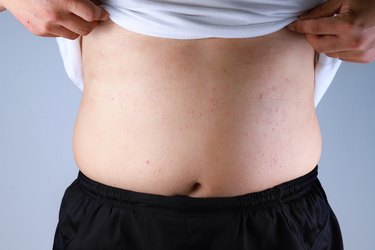
Rashes can occur for a number of reasons, especially in areas where there is a lot of warmth and moisture. Excess skin or fat can create skin folds, producing an ideal environment for rashes to develop. Depending upon the type of rash, certain treatments can make the rash worse and possibly cause the rash to spread to other areas of your body.
History
Video of the Day
Belly fat can cause rashes to develop since the skin folds over other areas of skin, creating a warm, moist environment for bacteria, fungus and yeast to thrive. The medical term is for this condition is intertrigo. Intertirigo is quite common in individuals with overweight and obesity, according to DermNet NZ. The rashes created by skin folds can become so severe that the rash can permanently damage your skin tissue.
Video of the Day
Effects
Intertrigo can cause the skin to become red, itchy, scaly and dry. The skin may even crack and bleed, according to the Mayo Clinic. Depending upon the type of rash caused by skin folds, you can experience rashes in small patches or the rash may run the entire length of the skin fold. If the rash becomes severe enough, it can burrow deep under the skin, affecting outer and inner layers of skin tissue.
Causes
Since the folds can trap moisture, bacteria and fungus, you may develop a bacterial infection such as atopic dermatitis or a fungal infection such as a yeast infection or athlete's foot. You could also have contact allergic dermatitis from using a particular soap, lotion or body spray. Folliculitis may also be present where ingrown hairs happen to develop under a fold of skin.
Prevention/Solution
Certain rashes, such as atopic dermatitis, can clear on their own by changing a few hygiene techniques and wearing different clothing. Keeping the area clean and dry will help to ensure that the rash will clear, as well as wearing loose clothing. Tight clothing does not allow your skin to breathe and locks in moisture. Avoid wearing body sprays and lotions that may be causing or irritating the rash. Other conditions such as a yeast infection or athlete's foot may be treated with over-the-counter anti-fungal creams, but always consult with your physician prior to treating your rash with OTC medications.
Warning
If you've ensured the area is clean and dry at all times and have made small changes, such as soaps, lotions, clothing and body spray and your rash has not cleared, you may need prescription strength medication. Do not allow the rash to spread deeper into underlying skin tissue, as this could result in deep scar tissue. Do not scratch the rash. If the rash is caused from a bacterial or fungal infection, the infection can become trapped under your fingernails, which could lead to it spreading to your face, hands or other parts of your body that you may touch.